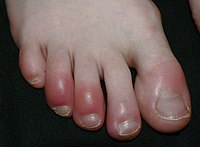
Photo from wikipedia
INTRODUCTION Recent research shows that in many countries, smokers who increased smoking during the COVID-19 pandemic outnumbered those who decreased it, despite higher exposure to COVID-19 severity and death. In… Click to show full abstract
INTRODUCTION Recent research shows that in many countries, smokers who increased smoking during the COVID-19 pandemic outnumbered those who decreased it, despite higher exposure to COVID-19 severity and death. In this study, we compared changes in smoking behavior in the initial and later stages of the pandemic and factors associated with lower smoking intensity. METHODS We conducted two survey rounds on representative samples, the first in the initial stage of the pandemic (11–19 May 2020) and the second in the latter stage (4–11 June 2021), in Serbia. Multinomial logistic regression was run to estimate associations between smokers’ characteristics and lower smoking intensity. In contrast to most studies that assess psychological factors affecting smoking in the pandemic, we focused on factual determinants of the change in smoking intensity. RESULTS The share of smokers who claimed to smoke more increased significantly, from 22.7% in May 2020 to 35.2% in June 2021. The share of smokers who reported a decrease in smoking only slightly increased, from 11.7% to 13.3%. The persistence of the pandemic considerably increased intentions to cease smoking, from 26.3% to 40%. Higher education (adjusted odds ratio, AOR=2.11; 95% CI: 1.08–4.13), income fall (AOR=2.14; 95% CI: 1.11–4.11), occasional smoking (AOR=4.24; 95% CI: 2.26–7.96) and recovery from COVID-19 (AOR=2.38; 95% CI: 1.23–4.60) increased the odds to reduce smoking during the pandemic. CONCLUSIONS Most smokers are unaware that consuming tobacco products increases exposure to health risks related to COVID-19, but those who get coronavirus infected tend to reduce smoking. This research highlights that tobacco control policy needs to be more proactive in creating public campaigns which demonstrate the severity of COVID-19 impact on smokers’ health. Such campaigns should mainly target those groups of smokers who are less able to curb their smoking intensity.
Journal Title: Tobacco Induced Diseases
Year Published: 2022
Link to full text (if available)
Share on Social Media: Sign Up to like & get
recommendations!